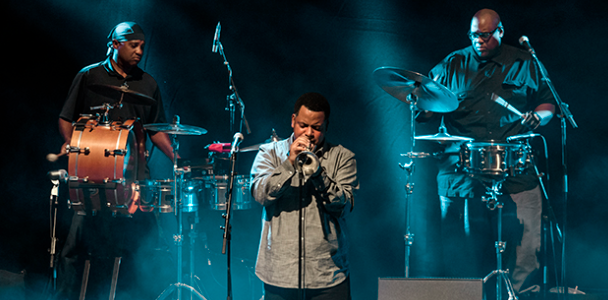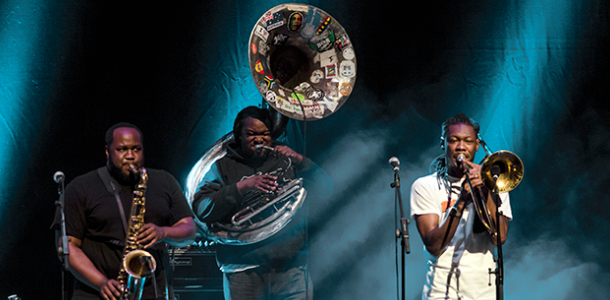A long way from their home in New Orleans, Louisiana, The Soul Rebels brought some heavy brass to the Melbourne Recital Centre ahead of their Bluesfest performance. As musicians, they were near perfect, blasting their way through an hour and a half of brassed-out soul, r n’ b, and hip hop.
The atmosphere in the venue was far more subdued than in New Orleans’ French Quarter, with the majority of the Tuesday night crowd feeling more comfortable in their chairs than standing up and physically showing their enthusiasm.
Comprised of two trumpets, two percussionists, two trombones, a sousaphone (with an Australian flag sticker on the bell), and tenor saxophonist/ band leader Erion Williams, the band were a tight collective. It was exciting to see variations in technique and solo phrasing between the younger musicians and their more experienced counterparts.
A standout performer was young trumpeter, Julian Gosin. He was adept at finding time in his solos amongst a frantic band and gave credence to Claude Debussy’s famous quote that, “music is the space between the notes.” The immense concentration on Gosin’s face when playing showed how seriously he was taking his role, which was well received by the audience.
There were a few concerned glances around the centre when he began rapping to Curtis Mayfield’s ‘Move On Up’, or as people born after 1975 refer to it as, ‘Touch The Sky’ by Kanye West. This generational divide was an undertone throughout the concert as the older members of the crowd would be tapping their foot to the original compositions whilst younger people were up and dancing to covers like Reel 2 Real’s instantly recognisable, ‘I Like to Move It’.

Visually entertaining synchronised steps and bell lifts were exciting and vocal harmonies during their take on the Eurythmics’ ‘Sweet Dreams’ were highlights of the show. There was a drum interlude at the halfway point of the performance that was more melodic and rhythmically diverse than seemed possible for two people. This demonstrated the skill and execution of the percussionists who, for the most part, were confined to keeping relatively basic rhythm as their frontline starred.
For everything they got right, seeing The Soul Rebels is not for the faint of heart or, more specifically, not for those with sensitive ears. Every song was turned up to 11, which forced a few audience members to leave mid-set with their fingers in their ears. Such aural intrusion mixed with a one-tempoed setlist meant that the patron had to be committed to the band to see it through. Being unable to appreciate the room’s dazzling sound quality due to the bulldozing brass section was a shame.
Marcus Hubbard and Williams soon requested that the audience “fix the problem” and stand up to dance. Much of the audience ignored this as they were content with watching the performance from their seats. They were not begrudged by those who were dancing, as it is a recital hall, after all, and the seats provided a comfortable vantage point.

When it was time for the encore, Williams repeatedly asked the crowd to follow the band on Twitter, Facebook, and Instagram (@soulrebelsNOLA for those interested). The band then rejoined and played their take on The Surfaris classic, ‘Wipeout’ and Pharrell Williams’ megahit, ‘Happy’.
An excellent group of talented musicians played to an audience who chose not to listen from the Second Line in New Orleans, but seated in a refined auditorium in Melbourne. The crowd appreciated The Soul Rebels, but perhaps the band would be better suited to a smaller club show or outdoor music festival (like Bluesfest) where fans would be free to dance with ease.




































